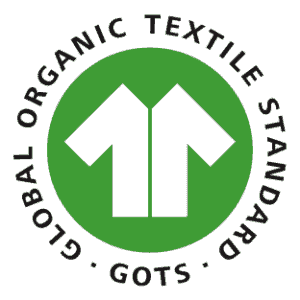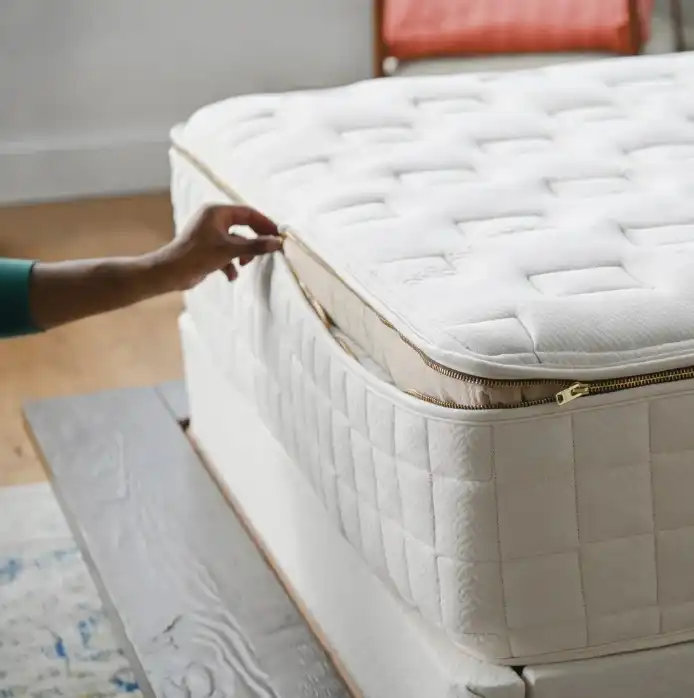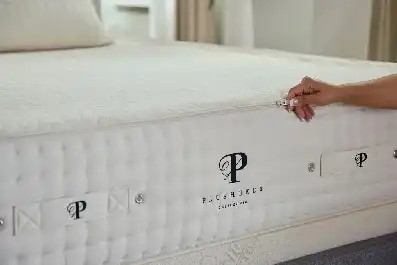- You are here:
- Home »
- Organic Mattresses »
- Latex Mattress Pros and Cons
Latex Mattress Pros and Cons
In this article, we’ll look at pros and cons of latex mattresses to help you choose the best mattress for your needs. You usually have three choices when picking a natural latex mattress. Latex mattresses can be made synthetically, naturally, or with a combination of natural and synthetic components.
The blend of synthetic and natural latex is the most popular type of latex mattress, but you do have the option of great all natural latex, or all-latex mattresses too. It’s something you usually have to read the fine print about to make sure it’s truly a 100% natural latex mattress, because even saying “natural latex” can include up to 30% synthetic materials as well.
One way to make sure you do get a truly safe, all-latex mattress is to check for certifications ensuring high standards are kept. You can look for certifications such as GOLS, Eco-Institut, and GOTS. You can read more about what those mean later on at the end of the article.
Latex mattresses can be worth the search and effort of finding a good one. They can be a wonderful mattress to meet your sleeping needs. If you’re trying to choose the right type of mattress, consider a latex mattress with these pros and cons in mind.

Cons of Latex Mattresses
Let’s start with the negatives. These depend on the buyer because some latex mattress owners have complaints that others do not. Sometimes, a point on this list is a problem for one person and not for another.
This is part of choosing and buying a mattress – you have to consider if these downsides are a deal breaker for you.
Firmness
The mattress can tend to be excessively firm, especially initially after purchase. The ILD, or Impression Load Deflection, is one way to measure how your latex mattress will feel. A higher ILD count indicates a firmer foam, while a lower count will feel softer.
But as with most mattresses, you may need to give it a couple of weeks to “break it in” before you can determine if it’s really too hard and firm.
Allergies
If you have a latex allergy, then a latex mattress may not be the best choice of mattress for you. The latex mattress is supposed to be safe for latex allergy sufferers because the manufacturing process washes out so many of the allergens, however, to be on the safe side, you may want to reconsider buying one.
Price
This is probably the biggest obstacle keeping people from buying a natural latex mattress. Natural latex is one of the most expensive materials for manufacturers to deal with. You do pay for what you get, so although you pay a hefty price, you are getting your money’s worth.
However, this is a “con” because it prevents many people from trying an all natural latex mattress and they choose memory foam beds instead. You can spend the same amount of money on a high-end conventional mattress, but you will lack the quality and comfort that a latex mattress can give you for the same price.
One solution to get around the high prices is to find lower deals by buying online. Usually buying a latex mattress at a local dealer is more expensive than buying online, check our list of affordable natural mattress manufacturers available online.
Leaving a Lasting Impression
When you find that a mattress forms an imprint where you sleep, this is called compression. This is usually only a complaint found with synthetic latex mattresses because natural latex generally doesn’t do this.
Some people have found this to be an irritation, not because it impacted their comfort or support, but rather because it does limit natural movement during sleep.
Heat
Some latex mattresses may sleep hot, but that does vary greatly. All-latex mattresses tend to be balanced about this because of their natural open-cell structure. But blends or synthetic latex types, especially those with closed cell foams or foam hybrids can cause you to overheat while you sleep.
Manufacturers also recommend having a breathable cover like natural cotton or wool to allow better airflow and ensure a cooler night’s sleep. Even with that, if you don’t choose the right type of mattress, you might notice a problem with heat retention.
If you think that an all latex mattress could make you sweat at night, consider innerspring mattresses with latex comfort layers. Due to their structure, they are more breathable and always sleep cool.
|
$1,399
|
$1,549
|
From $1399
|
Pros of Latex Mattresses
We’ve saved the best for last. Here are a few reasons to consider choosing a latex mattress for your bedroom:
Comfort
This is an important reason to choose a mattress because, after all, we do need to be comfortable to have a good night’s rest. Almost a third of people who own all natural latex beds report that it significantly reduces pain and even prevents pain because of its buoyant support.
The natural springiness relieves pressure points like your hips and shoulders to help your spine stay aligned for comfortable sleep. The structure of an all-latex mattress will give you support where it matters. You will find that the appropriate firmness will allow you to sleep better too. That leads me to the next positive thing about latex beds.
Customization
Organic latex mattresses allow some retailers to customize the mattress to your desired specifications. You can achieve the feeling you want or even have two different firmness levels on each side for you and your partner!
To find your ideal firmness, you can use the ILD scale. You can also choose to have unglued layers to make it possible for you to replace top layers once they get worn out. This can extend the life of your mattress too.
Motion Isolation
Motion isolation is one of many advantages of natural latex beds. You can move around in bed without disturbing your partner’s sleep because the natural density of the latex absorbs the movement. Your natural movement while you sleep will not be transferred through the dense material.
No Harmful Off-Gassing
An all-latex mattress, meaning there is no blend with synthetic materials too, will not give off nasty chemicals fumes or smells. Synthetic latex can tend to off-gas more than all-natural options. Even natural latex has a smell, but the smell is slightly sweet and not offensive to most people.
Also, it’s the type of off-gassing that is not harmful because it’s not caused by chemicals, so you can sleep in peace on an all-latex mattress. No off-gassing, means that a latex mattress is also a perfect non-toxic mattress for kids.
Durability
The natural materials in latex mattresses outlast most other types of mattresses with a lifespan of 10-12 years of comfort. The resilient material can give you proper support without sagging for years to come. Latex beds are usually heavy, but thankfully you don’t have to lift, flip, or turn them.
The material is able to retain its original shape through the years. This is especially true for all-latex mattresses. The synthetic blends may damage the durability and cause compression where it naturally would not occur.
|
$1,399
|
$999
|
$2.199
|
Safety
All natural latex mattresses, like all organic mattresses, have no petroleum based foams or adhesives involved in the manufacturing. This reduces indoor pollution in your home, not to mention it also reduces outdoor pollution from chemicals in factory production if your mattress contains no harmful substances.
As mentioned before, you can even find some latex beds that are Oeko-Tex 100 standard certified, Greenguard certified or Eco-Institut certified. This guarantees that no harmful toxins will be found in the end product – the mattress in your home. I’ll explain more about those certifications later.
Naturally Fire-Resistant
Latex is naturally fire-resistant meaning there’s little to no need for toxic flame retardants, such as fiberglass, to be added in manufacturing. Safer for you and the planet. Flame retardants commonly found in memory foam mattresses often contaminate water and air during manufacturing which has a lasting effect on the environment.
Hypoallergenic
Latex is naturally hygienic because of its antibacterial and antifungal properties. All-latex mattresses are mold/mildew resistant and dust mite resistant too. Because it repels dust mites, it significantly reduces allergens that could affect you year round.
Dust mites are a major cause of allergies because of the proteins they leave and keeping them at bay will keep you from suffering from allergies due to them.
Environmentally Friendly
The all-natural, raw materials for your latex mattress are harvested from plantations that are able to allow the tree to continue growing while tapping it for rubber. There’s no need to cut it down for harvest! This makes latex an incredibly sustainable and eco-friendly material option for mattresses.
In fact, between the long lasting mattress that biodegrades in the end, and the trees that can be tapped for up to 30 years, latex is the perfect natural material for someone concerned about the future of our planet.
Read More: How to Recycle a Latex Mattress?
If you find the right company with the right certifications, you can even be assured that no synthetic fertilizers were used to feed the plants and trees – only organic materials.
This means even more good things for the environment because there is no biodiversity loss or heightened global greenhouse emissions due to toxic fertilizers. Unlike memory foam mattresses, these eco-friendly mattresses reduce consumption and waste because of their high durability and biodegradability. It’s a win-win for you and the environment.
Read More: Is Natural Latex Biodegradable?
No Metal
If you’re concerned about electromagnetic radiation, this bed may be a good option for your peace of mind. There is no metal used and therefore no way that the mattress materials could be transmitting or amplifying the radiation.
Breathability
Latex has a natural open cell structure which allows for good airflow. This good circulation can prevent moisture buildup, and thus prevent mildew after a while of moisture being trapped in the mattress. You might even find that with an all-latex mattress, you could sleep cool at night thanks to the good airflow.
Different Firmness Levels
Natural latex mattresses are available in different firmness levels. By combining Talay and Dunlop latex layers, any firmness can be created. Firmnesses for latex beds range from soft to very hard and everything in between.
|
$1,549
|
$1549
|
$699
|
Natural vs Synthetic Latex
There are many options out there, but one type to consider is natural vs synthetic latex mattresses. Latex has been used in mattresses for centuries and can be found all over the world, but some people prefer natural or synthetic latex. What’s better: organic or synthetic? Which one should I buy? In this section, we discuss the differences between natural and synthetic latex:
- Manufacturing Process: Latex is a natural material harvested from rubber trees, but man-made synthetic latex is produced in a lab.
- Smell: Synthetic latex foam usually has an odor that is stronger and more abrasive than that of natural latex foam.
- Comfort: Synthetic latex foam has a more dull and less springy feel than natural latex foam, so doesn’t feel as supportive or as springy as 100% natural latex.
- Durability: Synthetic latex foam is generally not as durable as natural latex foam and tears easier
- Safety: It is uncommon to find synthetic latex foam that meets textile and furniture emissions standards such as ecoInstitut, Oeko-Tex and Greenguard. These standards are easily met by organic latex products that don’t contain any chemical fire retardants or other harsh chemicals.
- Price: Synthetic Latex is generally cheaper than Natural Latex
Read More: How to Clean a Latex Mattress?
Natural Latex vs Blended Latex
What are the differences between them and how do they stack up against each other in terms of comfort, durability, and cost? In this section we look at the differences between all-natural and blended latex:
- Price. Natural latex mattresses cost about 50% more than blended latex ones.
- Comfort. Natural latex mattresses have greater springiness than blended options. Generally speaking, the higher the percentage of natural rubber in a mattress, the better it feels.
- Durability. Natural latex resists compression better than blended options, so it lasts longer.
- Safety. As blended latex contains some synthetic latex, it’s bound to emit harmful chemicals and release unpleasant chemical smells.
Latex Mattress Certificates
If you’re convinced you want a latex mattress, you can begin searching for the right one. But, be careful and take your time to read the fine print if you’re looking for an all-latex option. Many companies are selling latex mattresses; some even claim to sell “all natural” latex mattresses.
To ensure your mattress’s true eco-friendliness and health and safety, you need to check that the mattress is certified. Don’t just trust the company’s claims. There are a few different certifications a mattress can have, but it’s important to identify and understand what they mean to make sure you purchase the mattress you want. Here’s a quick guide to some of the certifications you may see:

GreenGuard
Much like the eco-INSTITUT certification, this checks for low emission levels and little to no volatile organic compounds being off gassed in the end product. Greenguard Gold is also concerned with protecting vulnerable populations, so they try to keep people like the elderly and children safe.

Global Organic Textile Standard
As you can guess from the name, this certification has more to do with the production of materials for textiles. It monitors naturally-grown textile production through all stages of manufacturing, from the farm to the factory and then eventually to the shelf where you will buy it.
This is important for latex mattresses too because it will certify that the natural wool or cotton cover on your all natural latex mattress was indeed organic. The GOTS certification also has two types of labels – made with organic, meaning it contains at least 70% organic materials and organic, meaning it contains at least 95% or more organic materials.

Global Organic Latex Standard
This important certification is certainly one to look out for when you search for an all-natural latex bed. The GOLS guarantees that the latex your mattress is made of is 95% organic and free from all sorts of toxic chemicals like chlorine bleach, harmful dyes, and GMO’s. This certification goes hand in hand with the GOTS and eco-Institut certification.
If your latex bed is GOLS-certified organic it means the brand followed stringent requirements from the harvesting, manufacturing, packaging, and distribution of their product. The company also had to follow fair labor practices and maintain sustainability.

Oeko-Tex
This certification uses over 100 tests to verify the product contains no harsh chemicals. It tests textile products on almost every point, checking for things like heavy metals, harmful dyes, GMO’s and more. The OEKO-Tex 100 Standard certification takes their checks one step further by looking for substances that are not only harmful by law, but harmful for your health in general.

Eco-Institut
They certify that products are tested for volatile organic compounds. They ensure that a product is certified to have little to no emission levels of things like formaldehyde, heavy metals, fire retardants and other chemicals. This protects your home’s indoor air quality.
Conclusion
If you have seen some deal-breakers in the “cons” list, the latex bed might not be your best choice. But, otherwise, there are plenty of reasons to get an organic latex mattress for your bedroom. A big reason for choosing a mattress is comfort. It allows good sleep and may even relieve pain.
However, it’s important not to risk your health for the sake of comfort. A latex mattress can offer a safe, toxin-free option for comfort, support, pressure and pain relief. Plus, it’s a responsible, sustainable choice for the planet. Check our review of the best latex-free mattresses if you think that a latex mattress is not the best option for you.
About the Author Kamila Flieger
My name is Kamila, and I'm passionate about researching non-toxic, organic products for the home. I believe it's so important to create a safe and healthy environment for our families, and I enjoy helping others do the same.








